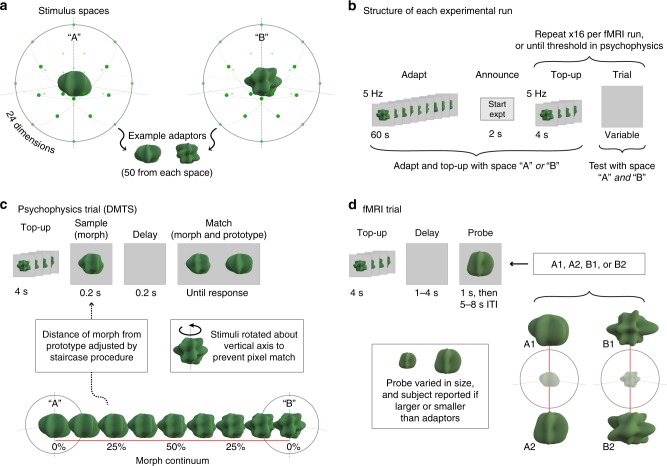Fig. 1.
Experimental design. a We sampled 3D shapes from a 24-dimensional, radial frequency stimulus space in which the dimensions were defined by the frequencies, amplitudes, and phases of 8 sinusoids. Two visually distinct shapes from this space were chosen as prototypes A and B. For each prototype, 50 adaptor stimuli were generated in the multidimensional space by jittering the orientation and amplitude of the 8 sinusoidal components, producing two distinct shape classes. b In the beginning of each experimental run (for both psychophysics and fMRI experiments), subjects were presented with a series of shapes from one of the two shape classes for 60 s at a rate of 5 Hz (adapt phase). All trials began with a top-up adaptation period of 4 s at 5 Hz, followed by trial events that differed for the psychophysics and fMRI experiments (c, d). In all experiments, adaptation condition (A or B) was blocked in counterbalanced order across subjects. c Morph stimuli were generated along the direction that connected the two prototype shapes. Subjects first saw a morph and, after a brief delay, the same morph and a prototype. Subjects were then asked to report which of the two shapes in the second interval matched the first shape (i.e., which of the two shapes was a morph). To avoid pixel-based matches, each morph and prototype shape was displayed as a static image in one of two possible rotations. Trials using A and B as prototypes were interleaved in a run, and separate 1-up, 3-down staircases controlled the morph value for each prototype. d Two distinct probe stimuli were created for each shape class (A1, A2 and B1, B2) along axes passing through the prototype stimuli. After a top-up adaptation phase and a variable interstimulus interval, subjects saw one of the four probe stimuli and were asked to report whether the probe was larger or smaller than the adaptors in the top-up phase. We measured the BOLD response to each of the four probe stimuli and calculated the multivariate pattern similarity between the two probe shapes (e.g., A1 and A2) after adaptation to the same shape class (A) compared to adaptation to the different shape class (B)

